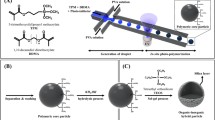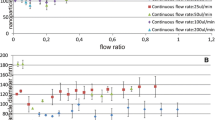Abstract
New developments in microfabrication techniques have enabled the fabrication of very efficient emulsification microstructured devices which along with capillaries of small dimensions allow emulsifying a fluid in another immiscible fluid. Droplet-based microfluidics is a versatile tool for widespread applications due to the following advantages: production of monodisperse droplets, high surface-area-to-volume ratio, and independent control of each droplet. The main goal of this work was to design cationic polystyrene microspheres with the developed surface structure using microfluidic technology. We investigated the influence of monomer phase composition on the size, polydispersity index (PDI), the size distribution and surface structure the resulting microspheres. Polymer microspheres with different surface structure are thus obtained as proven by extensive morphological characterizations using electronic and optical microscopies. Moreover, the structure of crosslinked microspheres was investigated by FTIR spectroscopy. Besides morphology, microspheres with various compositions were synthesized and their potential application highlighted: microspheres with grafted chains of polymer stabilizer (PVP) in surface layer have great potential for effective sorption of p-xylene from physiological saline.

Graphical abstract









Similar content being viewed by others
References
Amoyav B, Benny O (2019) Microfluidic based fabrication and characterization of highly porous polymeric microspheres. Polymers. https://doi.org/10.3390/polym11030419
Shevchenko N, Pankova G, Iakobson O, Abiev R, Svetlov S, Ilin N (2020) Microfluidic synthesis of monodisperse porous polystyrenemicrospheres for sorption of bovine serum albumin. J Microencapsul 37:457–465
Workman VL, Dunnett SB, Kille P, Palmer DD (2007) Microfluidic chip-based synthesis of alginate microspheres for encapsulation of immortalized human cells. Biomicrofluidics. https://doi.org/10.1063/1.2431860
Bian Q, Qiu K, Liu J, Niu Y, Liu Y, Hu J, Yang G (2015) Preparation of poly{styene-co-4-(4-vinylphenoxy) phthalonitrile} nicrospheres by a new approach of “co-dissolution” and its function development. Macromol Res 23:628–635
Young C, Rozario K, Serra C, Poole-Warren L, Martens P (2013) Poly(vinyl alcohol)-heparin biosynthetic microspheres produced by microfluidics and ultraviolet photopolymerisation. Biomicrofluidics 7:044109
Murua A, Portero A, Orive G, Hernández R, Castro M, Pedraz J (2008) Cell microencapsulation technology: towards clinical application. Controlled Release 132:76–83
Xia H, Wan G, Yang F, Wang J, Bai Q (2016) Preparation of monodisperse large-porous silica microspheres with polymer microspheres as the templates for protein separation. Mater Lett 180:19–22
Shan L, Sun Y, Shan F, Li L, Xu ZP (2020) Recent advances in heparinization of polymeric membranes for enhanced continuous blood purification. J Materials Chemistry B. https://doi.org/10.1039/c9tb02515d
Shevchenko N, Evseeva T, Shevaldysheva D, Pankova G, Shabsel’s B, Men’shikova A (2013) Seeded polymerization as a method for producing hollow monodisperse microspheres. Colloid Journal 75:460–472
Liu X, Xu Y, Wu Z, Chen H (2012) Poly(N-vinylpyrrolidone)-modified surfaces for biomedical applications. Macromol Biosci 13:147–154
Łojszczyk I, Kuźmińska A, Butruk-Raszeja B, Ciach T (2020) Fenton-type reaction grafting of polyvinylpyrrolidone onto polypropylene membrane for improving hemo- and biocompatibility. Mater Sci Eng C. https://doi.org/10.1016/j.msec.2020.110960
Dou L, Bertrand E, Cerini C, Faure V, Sampol J, Vanholder R, Berland Y, Brunet P (2004) The uremic solutes p-cresol and indoxyl sulfate inhibit endothelial proliferation and wound repair. Kidney Int 65:442–451
Jourde-Chiche N, Dou L, Cerini C, Dignat-George F, Vanholder R, Brunet P (2009) Proteinbound toxins—update. Semin Dial 22:334–339
Liabeuf S, Barreto D, Barreto F, Meert N, Glorieux G, Schepers E, Temmar M, Choukroun G, Vanholder R, Massy Z (2010) Free p-cresylsulphate is a predictor of mortality in patients at different stages of chronic kidney disease. Nephrol Dial Transplant 25:1183–1191
Kikuchi K, Itoh Y, Tateoka R, Ezawa A, Murakami K, Niwa T (2010) Metabolomic search for uremic toxins as indicators of the effect of an oral sorbent AST-120 by liquid chromatography/ tandem mass spectrometry. J Chromatogr B Analyt Technol Biomed Life Sci 878:2997–3002
Pham N, Recht N, Hostetter T, Meyer T (2008) Removal of the protein-bound solutes indican and p-cresol sulfate by peritoneal dialysis. Clin J Am Soc Nephrol 3:85–90
Ankawi G, Fan W, Pomarè MD, Lorenzin A, Neri M, Caprara C, Ronco C (2018) A new series of sorbent devices for multiple clinical purposes: current evidence and future directions. Blood Purif. https://doi.org/10.1159/000493523
Thommes M, Cychosz K, Neimark A (2012) Advanced physical adsorption characterization of Nanoporous carbons. Novel Carbon Adsorbents. https://doi.org/10.1016/b978-0-08-097744-7.00004-1
Men’shikova A, Inkin K, Evseeva T, Skurkis Y, Shabsel’s B, Shevchenko N, Ivanchev S (2011) Bioligand carriers based on methyl methacrylate copolymers with N-vinylformamide or glycidyl methacrylate. Colloid J 73:76–82
Zhu P, Wang L (2017) Passive and active droplet generation with microfluidics: a review. Lab Chip 17:34–75
Song J, Winnik M (2005) Cross-linked, monodisperse, micron-sized polystyrene particles by two-stage dispersion polymerization. Macromolecules 38:8300–8307
Yanan L, Wang L, Yuhong M, Lianying L, Wantai Y (2015) Direct one-pot synthesis of chemically anisotropic particles with tunable morphology, dimensions, and surface roughness. Langmuir 31:925–936
Li B, Xu Y, Wang M, Ge X (2013) Morphological control of multihollow polymer latex particles through a controlled phase separation in the seeded emulsion polymerization. Langmuir 29:14787–14794
Menshikova A, Evseeva T, Skurkis Y, Tennikova T, Ivanchev S (2005) Monodisperse carboxylated polystyrene particles - synthesis, electrokinetics and adsorptive properties. Polymer. 46:1417–1425
Okubo M, Hattori H (1993) Competitive adsorption of fibrinogen and albumin onto polymer microspheres having hydrophilic/hydrophobic heterogeneous surface structures. Colloid Polym Sci 271:1157–1164
Men’shikova A, Evseeva T, Skurkis Y, Shabsel’s B, Ivanchev S (2004) Synthesis of monodisperse polystyrene particles with a controlled graft copolymer structure in the surface layer. Polym Sci Ser A 46:898–905
Meijers B, Weber V, Bammens B, Dehaen W, Verbeke K, Falkenhagen D, Evenepoel P (2008) Removal of the uremic retention solute p-cresol using fractionated plasma separation and adsorption. Artif Organs 32:214–219
Acknowledgements
The study was carried out with the financial support of the Russian Foundation for Basic Research in the framework of scientific project No. 18-03-00206-a.
Author information
Authors and Affiliations
Corresponding author
Ethics declarations
Disclosure statement
The authors report no conflict of interest. The authors alone are responsible for the content and writing of this article.
Additional information
Publisher’s note
Springer Nature remains neutral with regard to jurisdictional claims in published maps and institutional affiliations.
Rights and permissions
About this article
Cite this article
Shevchenko, N., Svetlov, S. & Abiev, R. Continuous-flow microfluidic device for synthesis of cationic porous polystyrene microspheres as sorbents of p-xylene from physiological saline. J Flow Chem 11, 751–762 (2021). https://doi.org/10.1007/s41981-021-00142-9
Received:
Accepted:
Published:
Issue Date:
DOI: https://doi.org/10.1007/s41981-021-00142-9




